Adobe ad0-e117 practice test
Adobe Experience Manager Architect Master Exam
Last exam update: Jun 25 ,2025
Question 1
A large retail customer is building their ecommerce platform on AEM. Several third-party vendors sell
products through their site. Those vendors need to review and verify the content close to production
before the content goes live and the customer wants to provide them a restricted environment.
Which approach should the Architect recommend?
- A. Give third-party vendors access to the Author Server
- B. Use the Preview Capabilities of AEM Author Server
- C. Export content as PDF and share with the vendors
- D. Add a Publish (preview) Server and provide access
Answer:
D
Question 2
A media company wants to use AEM as content hub for multiple customer touch points:
Brand-specific marketing websites hosted on AEM Sites
Single Page Applications using headless content
Native mobile applications
Content offers in Adobe Target
The company wants to manage its content efficiently with its small editor staff. Text should be
entered and reviewed only once, then reused for all touch points.
How should an Architect incorporate these requirements into a solution that leverages AEM Sites
features?
A)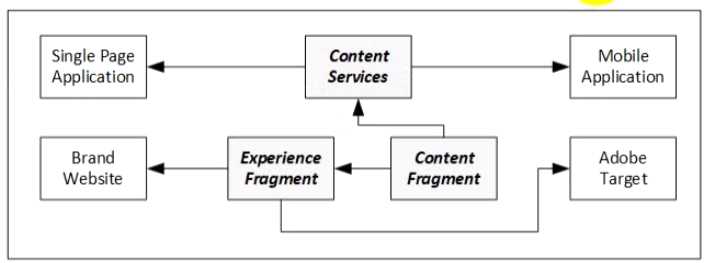
B)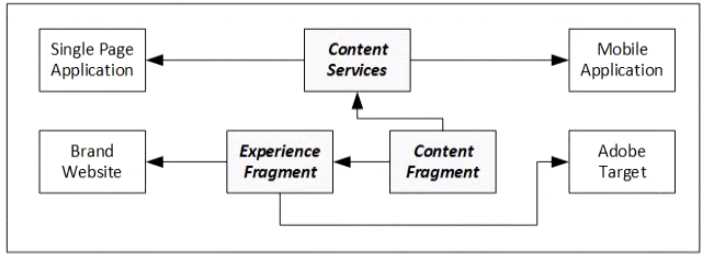
C)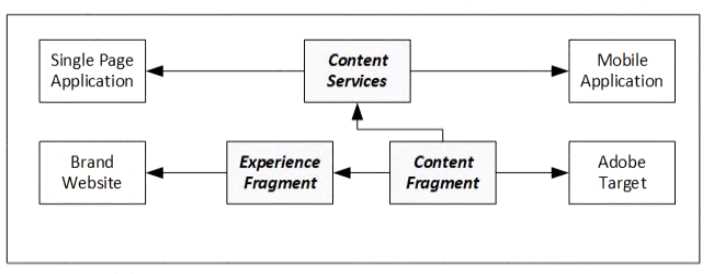
D)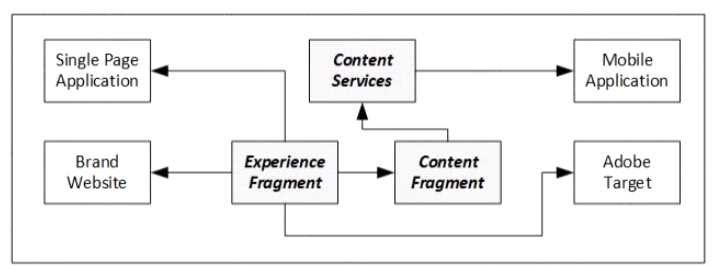
- A. Option A
- B. Option B
- C. Option C
- D. Option D
Answer:
D
Question 3
AEM Site users report that the web content pages render very slowly. An Architect notices that the
CPU usages of the AEM Publish instances are spiking and reviews the following entry in the log:
[Frt Nov 27 23:11:00 2019] [I] [pid 16004 (tid 140134145820416)] Current cache hit ratio: 47.94 %
What should the Architect do to increase the dispatcher cache ratio and prevent the AEM Publish
CPU usage spikes?
- A. Review and optimize the Dispatcher cache configuration
- B. Add additional AEM instances to the Publish Farm
- C. Create a cron job that will delete the dispatcher cache on a regular basis
- D. Add additional dispatcher servers
Answer:
C
Question 4
A client's marketing pages are generally slow to load which is causing a significant drop in sales. All
other AEM pages load within expected performance guidelines regardless of whether the visitor is
being served the desktop or mobile experiences.
The marketing pages typically get slower when multiple external campaigns such as Facebook and
AdWords drive traffic to those pages. The page performance tends to dip during high traffic periods.
Internal campaign clicks such as those from hero images use similar campaign codes as external
campaign traffic.
What should the Architect do to resolve this issue?
- A. Modify the dispatcher.any file's section to ignore campaign-based URL parameters
- B. Set AEM to use GZIP compression instead of the web server's compression
- C. Add a new dispatcher farm to assist with the client's marketing pages
- D. Convert the marketing pages to a responsive design instead of an adaptive design
Answer:
D
Question 5
A client is modernizing some of their AEM sites to go from static to editable templates so they can
use the latest features around has the following parameters:
The client currently has a dozen static templates that they want to move to editable templates.
The existing pages use the parsys paragraph system for storing components.
Each page based on one of the static templates has its own custom properties tab that is unique
for that template type.
The client wants template authors to be able to create the editable templates.
Which approach should an Architect use to meet these requirements?
A.
1. Use a new page component for editable templates based on the core components page
component
2. Migrate page properties to respective components dialogues
B.
1. Use a new page component for editable templates based on the core components page
component
2. Convert page properties to policies
C.
1. Use the same page components for editable templates
2. Use a new template type for each static template
D.
1. Use the same page components for editable templates
2. Create a new editable template based on each of the existing page components
Answer:
D
Question 6
An AEM Sites implementation is migrating from on-premise to AEM as a Cloud Service. Previously,
the application was deployed in a single package for both code and access policy nodes. After initial
deployment and testing in the new infrastructure, it is reported that user permissions are not
working as expected.
What change should the Architect make to address this issue?
- A. Update package metadata to use MergePreserve for handling access policy nodes
- B. Move access policy nodes to a dedicated package and install manually
- C. Refactor access policy nodes to Apache Sling JCR Repoinit scripts in the same package
- D. Document permissions and request the Customer Success Engineer to configure
Answer:
A
Question 7
Refer to the exhibit.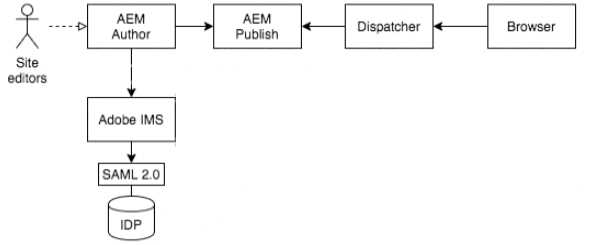
A customer has SSO on its AEM Author environment using Adobe IMS, which is integrated with the
customer's IDP using SAML The customer plans to roll out a new secured website on AEM where SSO
authentication is required for end users. The end user accounts are also managed in the customer's
existing IDP.
How should the Architect set up the authentication for the website?
- A. Integrate AEM Publisher using SAML with Adobe IMS
- B. Set up CUG and use User Synchronisation from Author to Publisher
- C. Integrate AEM Publisher using SAML directly with the IDP
- D. Integrate AEM Publisher using oAuth with Adobe IMS
Answer:
A
Question 8
A client is migrating the content from a legacy website to an existing AEM implementation. An
Architect evaluates the content of the legacy site and determine-that there are approximately 20.000
pages with a common structure, and a few hundred pages that do not follow a pattern. The client
wants to complete the migration as soon as possible.
Which approach should the Architect recommend for the content migration?
- A. Migrate all common pages using the ETL procedure with multiple rounds
- B. Migrate all common pages using the ETL procedure and use manual authoring for the rest
- C. Use Site importer to import the content into AEM
- D. Recreate the entire content manually with a group of Content Authors
Answer:
D
Question 9
During the implementation of a public-facing website based on AEM as a Cloud Service, the
customer raises an additional requirement to have a commenting functionality for end users
implemented on the pages.
What should the Architect do to make the design a future proof solution?
- A. Save comments in JCR and leverage Sling Distribution to synchronize comments between publishers
- B. Integrate a third-party solution to store comments externally
- C. Use MongoDB as provided with AEM as a Cloud Service to store the comments
- D. Save comments in JCR and leverage reverse replication to synchronize comments via author
Answer:
C
Question 10
A client's site does not show the latest page content for some site visitors. The client has two data
centers with each configured with a Dispatcher connected to two Publish machines. The site load
issue only occurs intermittently for visitors from one of the data centers.
Which step should the Architect take to resolve the issue?
- A. Disable caching on all impacted data centers Dispatchers to force the Publish machines to serve the page content
- B. Check the Publish instance(s) attached to the Dispatcher associated to the impacted data center
- C. Check the SSL certificate on the impacted data center's load balance.
- D. Review the log files on the Author instances to determine if there are any template errors
Answer:
C
Question 11
A website built on AEM Sites displays the company's stock price in the footer of all pages. The stock
data is retrieved from a third party REST service using two-way SSL and rendered in an AEM
component using HTL During performance testing in the last development sprint it becomes
apparent that the third party service sometimes takes up to 30 seconds to respond, which degrades
the overall site performance.
How should an Architect address this issue?
- A. Call the REST service directly from the browser
- B. Temporarily remove the component from all content
- C. Load the stock data component asynchronously
- D. Add a 5 second timeout to the REST call
Answer:
C
Question 12
A customer is migrating from their On-Premises AEM 6.4 instances to AEM as a Cloud Service. Next
to the required code refactoring, a content migration of approximately 100,000 pages needs to be
performed. The customer wants the content freeze period to be limited so that editors can continue
to do content actions as long as possible.
Which two recommendations should the Architect make for the migration of the content pages?
(Choose two.)
- A. Migrate the content using Lazy Content Migration approach
- B. Upscale the memory of the On-Premise AEM instance
- C. Migrate content deltas using a query-based packaging tool
- D. Ensure sufficient storage space on the On-Premise AEM instance
- E. Migrate the content using the Content Transfer Tool
Answer:
B, D
Question 13
A new AEM Sites implementation includes a component that lists the 10 most recently published PDF
documents in AEM Assets. The component works as expected during development and passes QA
testing. The business starts to use it while entering content and uploading assets in preparation for
go-live. A few days later, the component's PDF list is empty.
What is the most likely cause of the issue?
- A. A PDF with too large file size has been uploaded.
- B. The component is missing a matching Oak index.
- C. The component is missing the HTL display context to escape the PDF title.
- D. A PDF with incorrect MIME type has been uploaded.
Answer:
A
Question 14
AEM as a cloud service introduces major changes in the architecture by using containers. Which key
architectural change was necessary to allow this to occur?
- A. Using Adobe 10 for asset ingestion and processing, storing it on a separate blob and providing AEM with metadata
- B. Using sling content distribution as the replication mechanism
- C. Using MongoDB for Author environment
- D. Isolating /app and /libs from the content, configurations and state mgmt.
Answer:
D
Question 15
A retail customer with an international presence and both in-store and online sales needs a new
assets platform. The customer decides to use AM assets. The customer's sites will continue to run
on their proprietary CMS for websites.
The customer wants to be able to scale the platform for spikes in user traffic such as on local sales or
online marketing campaigns. Under some circumstances, the customer also has a higher load of
editors for a certain period of time.
Which architecture should an Architect use for this business case?
- A. An AEM Publish instance on Adobe Managed Services with auto scaling
- B. An AEM as a Cloud Service Sites with Dynamic Media
- C. An AEM Assets setup on Adobe Managed Services with Cloud Manager
- D. An AEM as a Cloud Service Assets setup using the combined CDN for delivery
Answer:
C